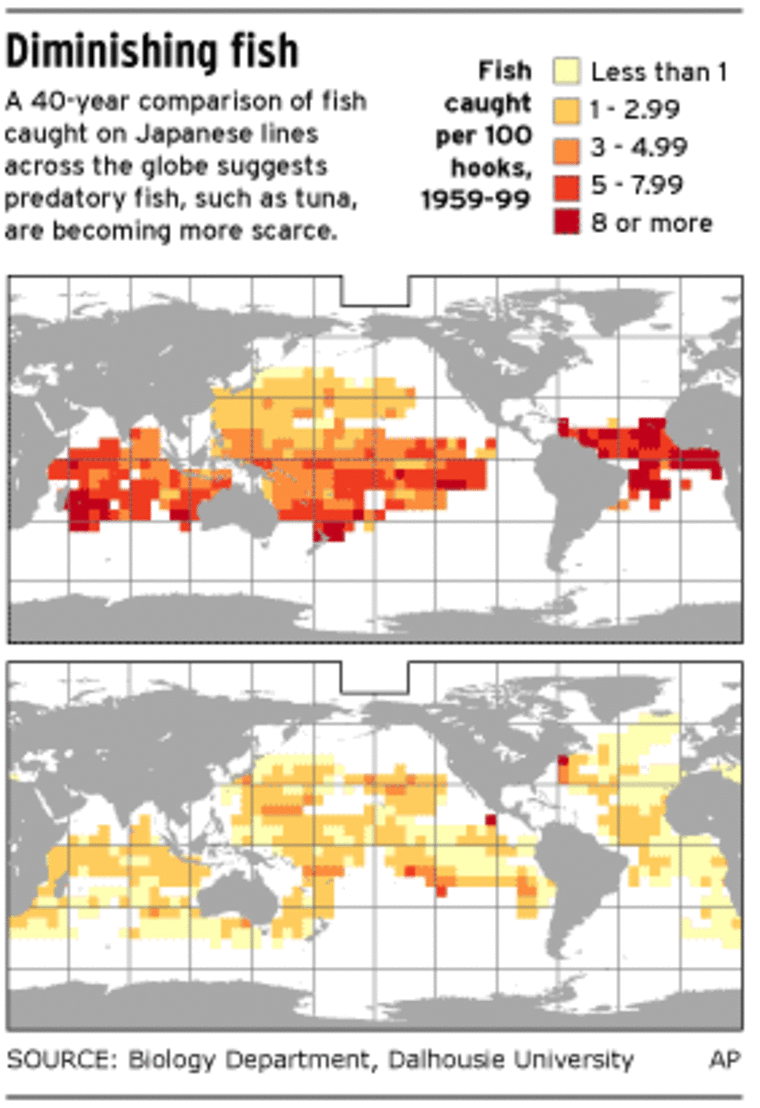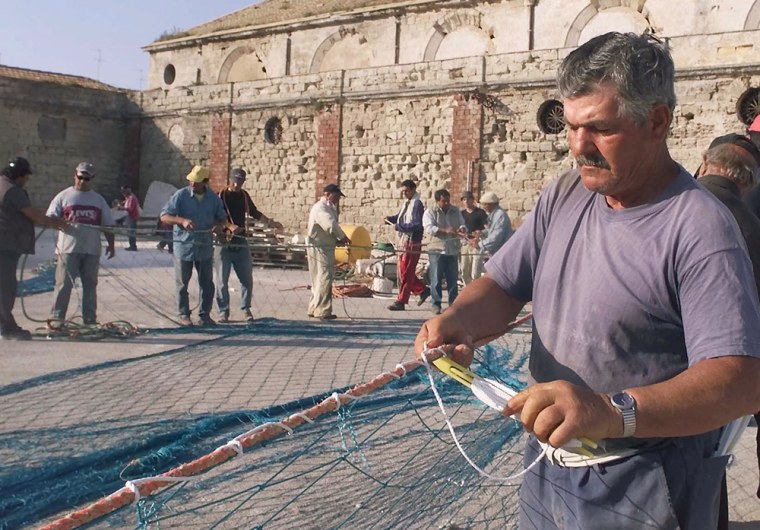Over thousands of springtimes, as far back as Homer’s Odyssey, the fishermen of Favignana have battled giant bluefin tuna lured into vast chambers of intricate netting. This year, the nets were empty.
The ancient “mattanzas” (slaughters) of Atlantic tuna that come to spawn in the Mediterranean are now all but gone. The craving for sashimi in Japan and the world beyond has taken its toll, but that is only part of it.
Marine biologists say not only bluefin tuna but also other fish stocks are plummeting across the world, upsetting delicate natural food chains. Some fear irreversible damage has already been done.
Even worse, international law experts add, little is being done to stop it. Despite all the evidence, high-tech fleets probe the last deepwater refuges, hardly troubled by authorities.
Legal quotas are too high, specialists say, and in any case are often pointless because too many crews lie about their catch.
Empty nets at Favignana, a butterfly-shaped islet off Trapani at the western edge of Sicily, are only one small sign of the times.
“This is no sudden crash, but rather an extremely slow-speed fatal collision,” said Carl Safina, founder of the conservationist Blue Ocean Institute on Long Island in New York.
For decades, he said, the world has moved blindly toward a precipice. “We have been confronted with signs and warnings and a clear view of the danger. And now we have fallen off. We may deserve it, but our children do not.”
Safina reflected views heard in a broad range of interviews in North America and Europe, from environmental activists to government-funded specialists charged with helping to set fishing limits.
Some are more optimistic, arguing that careful management can restore stocks to sustainable levels, but none dispute that urgent action is essential.
Scientists blame worldwide overfishing by private fleets, often with their governments’ complicity. Even where laws and accords are in place, they say, there is seldom more than token enforcement.
Bluefin can fetch $150,000
With a single bluefin worth as much as $150,000 on the Tokyo market, Italian and Russian organized crime is now involved, U.N. experts say.

University of British Columbia researchers sounded the alarm in 2001, reporting that some fish populations had fallen by as much as 85 percent. They said China drastically underreported its catch.
The report, directed by Daniel Pauly, said declassified Cold War technology, aircraft, and U.S. monitoring of water temperatures and ocean bottoms help fisherman find hideouts once beyond their reach.
A later study by Ran Myers and Boris Worm of Nova Scotia’s Dalhousie University reported drops of 90 percent among critical stocks. That brought protests from fishing industry officials, who cited other surveys showing smaller declines.
“This is only quibbling over numbers,” Safina said. “If it is 60 percent now and not 90 percent, then just wait five years.”
Beyond uncontrolled fishing, specialists see damage from pollution, silt runoffs from over-engineered river systems, and the still uncertain impact of global warning.
Not all tuna in danger
Tuna is a particular problem.
Such common varieties as skipjack, found canned in supermarkets, fetch lower prices and are not in immediate danger. But prized bluefins are hunted down for sophisticated worldwide networks of Japanese buyers.
About 20 percent of the world’s dwindling supply is caught in the Mediterranean, where tuna stocks are most threatened. And bluefin are also endangered in the Atlantic and Pacific.
The competition is fierce. At remote ports in Maine, boats that bring in bluefin find Japanese agents on their cell phones, eager to bid for the fish and ship them to Tokyo in coffin-like containers packed with ice.
Since these giant tuna might live 30 years, their plight affects an entire complex food chain, which already suffers from other types of overfishing.
In the early 1950s, the global tuna catch was less than 500,000 tons. By 2001, it had surpassed 3.7 million tons.
Serge Garcia, a Frenchman who supervises fish-monitoring programs at the U.N. Food and Agriculture Organization in Rome, says he’s deeply disturbed by nearly every trend he sees.
As a scientist who answers to each of the FAO’s member nations, he steers clear of advocacy. But, he said, the evidence speaks for itself: “Wherever you look, the numbers are going down.”
A counting issue
Garcia said the main problem is that since ocean fish cannot be accurately counted, no one can be certain about numbers. As a result, fishermen and conservationists push data to opposite extremes.
But, he said, scientists have a clear idea of the downward trend. “I don’t think it is wise to wait until this is proven right beyond any doubt,” he said. “By then, it will be too late.”
He calculated that fleets should be reduced by 30 to 40 percent to preserve stocks.
The ancient methods of Favignana focused on single schools, in which the biggest fish habitually swim first. This assured a lucrative catch without damage to sustainability.
Now most bluefin are caught on long lines. Other tuna are scooped up by purse-seine nets which catch whatever enters their broad openings. Huge numbers of untargeted fish are dumped back, dead in the water.
Using almost weightless nylon-Kevlar lines up to 2,500 feet long and equipped with lights and tiny cameras, Garcia said, fisherman can locate giant old tuna hiding in underwater caves.
“Only one of these big tuna can be worth as much as the most expensive Mercedes-Benz,” Garcia said. “How do you expect criminal organizations not to want to be in on it?”
He said Mafia-owned fishing operations launder money from other activities and exploit official fishing subsidies. Other operators, he added, push for quick and maximum profit in case enforcement is tightened.
“It’s warfare out there, complete with military technology,” Garcia said. Within 20 years, he predicted, only the wealthiest will be willing to pay the necessary prices for the best cuts of tuna.
“It is the height of absurdity,” says marine biologist Chato Osio at the Worldwide Fund for Nature Mediterranean office in Rome. “Sicily sends its best tuna to Japan, and Sicilians eat inferior tuna they import from Asia.”
Even if commercial boats respected Mediterranean quotas, he said, the annual 32,000-ton limit for tuna is already too high to protect the threatened fish.
The WWF and other groups campaign for fishing moratoriums in sensitive areas as well as rigorous patrols to enforce quotas.
Tuna ranches a new trend
Some experts put hope in tuna ranches, which have grown fast since 1997. These are not breeding centers, as are common for salmon, but rather holding pens for wild tuna that are caught but not landed.
At 30 Mediterranean sites, captured tuna are held in net corrals for five to 20 months until they fatten.
Proponents say this allows prices to stabilize and adds more meat to the market. But in practice, the WWF says, tuna penning wreaks its own sorts of havoc by disrupting natural cycles and seasonality, and by opening new markets for tuna. These, a WWF report says, have “made the situation of wild stocks even more perilous.”
Francesca Ottolunghi, a marine biologist who advises the Italian fishing industry, calls WWF’s positions too extreme. She predicts that farms will eventually raise tuna safely from eggs. But, like the environmentalists, she sees danger in illegal fishing.
“This is the biggest problem,” Ottolunghi said. “Nobody has control. You can say anything you want, but there is no enforcement.”
'Beautiful life has turned ugly'
None of this is news to the Favignana fisherman, whose annual running of the tuna has dwindled from the mainstay of the world’s biggest cannery to a subsidized curiosity for tourists.
Once celebrated as valiant holdouts of an ancient way of life, these men now survive on odd jobs and hang around the wharf exchanging tales of the good old days.
“Maybe it’s not over completely,” said sunburned, barrel-chested Giocchino Cataldo. “And maybe it is. Either way, this beautiful life has turned ugly.”
Cataldo’s title, “rais,” or boss, comes from North African Arabs who once colonized Sicily. He decides when, where and how to trap the tuna.
With a prodigious memory, he jotted down the name and years of reign for every rais over the past century. Then, he grimly recited a litany of dwindling catches.
A marked change began in the 1960s, when Japanese and Soviet trawlers began to prowl the Mediterranean. Now Koreans, Chinese and Taiwanese, among others, are major players.
Last year, when the Favignana mattanza brought in bluefin, Japanese buyers snapped them up and shipped them to Tokyo. Sicilian markets offered cheaper cuts from less valuable types of tuna.
This year, Cataldo’s fishermen put their nets in the water but they came up empty.
In the mainland fishing port of Bonagia, near Trapani, the nets were kept ashore this year in protest at a nearby tuna farm that has attracted Japanese interest.
Without the Japanese to buy their offshore catch, “it is the end for us,” said Salvatore Spataro, the Bonagia rais. But he suspects the old gods may still be with him. A winter storm disturbed the farm enclosure, and more than 2,000 tuna escaped.
Atlantic bluefin, with ancient instincts, follow their internal radar through the Straits of Gibraltar each year for springtime spawning in the Mediterranean.
How catches are determined
The catch limits are set by a Madrid-based semi-official body, the International Commission for the Conservation of Atlantic Tuna, or ICCAT, with members from governments and industry.
Similar bodies look after tuna populations elsewhere in the world.
But they can only ask governments to provide enforcement, and many scientists say they lean too far toward fishing interests.
Safina calls ICCAT “the International Conspiracy to Catch All Tuna,” accusing it of skewing data to favor fishermen.
Even with the best intentions, governments can only patrol within their territorial limits, often no more than 12 miles and seldom more than 200 miles.
The FAO uses figures supplied by member nations, but tracks a fast-rising category labeled IUU, for illegal, unreported and unregulated fishing.
In theory, commercial fishermen should want to protect stocks to guarantee their own future livelihood. In practice, the experts say, many captains opt for maximum immediate profit.
At Favignana’s port, the drama comes eerily to life at the cathedral-like cannery, now abandoned.
Its stone walls are chiseled with record catches from when the Florio family employed workers by the hundreds to can tuna shipped around the world. In 1857, the total was 10,159 tuna.
Now the only cannery in the area is on the Sicilian mainland, and its tuna is shipped in from North America or Asia.
Giuseppe Giangrazzo, a tuna man for 40 years who is live-in caretaker, now leads the occasional visitor on a bittersweet tour.
“This was something to see,” he said, as he showed a huge room of rotting ropes and empty hooks where freshly caught tuna used to be hung. “Now it is gone forever.”
